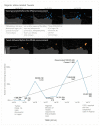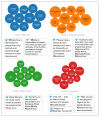What can we learn about the Ebola outbreak from tweets?
- PMID: 26042846
- PMCID: PMC4591071
- DOI: 10.1016/j.ajic.2015.02.023
What can we learn about the Ebola outbreak from tweets?
Abstract
Background: Twitter can address the challenges of the current Ebola outbreak surveillance. The aims of this study are to demonstrate the use of Twitter as a real-time method of Ebola outbreak surveillance to monitor information spread, capture early epidemic detection, and examine content of public knowledge and attitudes.
Methods: We collected tweets mentioning Ebola in English during the early stage of the current Ebola outbreak from July 24-August 1, 2014. Our analysis for this observational study includes time series analysis with geologic visualization to observe information dissemination and content analysis using natural language processing to examine public knowledge and attitudes.
Results: A total of 42,236 tweets (16,499 unique and 25,737 retweets) mentioning Ebola were posted and disseminated to 9,362,267,048 people, 63 times higher than the initial number. Tweets started to rise in Nigeria 3-7 days prior to the official announcement of the first probable Ebola case. The topics discussed in tweets include risk factors, prevention education, disease trends, and compassion.
Conclusion: Because of the analysis of a unique Twitter dataset captured in the early stage of the current Ebola outbreak, our results provide insight into the intersection of social media and public health outbreak surveillance. Findings demonstrate the usefulness of Twitter mining to inform public health education.
Keywords: Data mining; Ebola outbreak; Social media.
Copyright © 2015 Association for Professionals in Infection Control and Epidemiology, Inc. Published by Elsevier Inc. All rights reserved.
Figures





References
-
- Ansumana R, Bonwitt J, Stenger DA, Jacobsen KH. Ebola in Sierra Leone: a call for action. Lancet. 2014;384:303. - PubMed
-
- Gatherer D. The 2014 Ebola virus disease outbreak in West Africa. J Gen Virol. 2014;95:1619–24. - PubMed
-
- Green A. Ebola emergency meeting establishes new control centre. Lancet. 2014;384:118. - PubMed
-
- Dolan N. Infectious disease surveillance update. The Lancet. 2014;14
-
- Torjesen I. Two doctors die from Ebola and lives of others under threat in West Africa. BMJ. 2014;349:g4895. - PubMed
Publication types
MeSH terms
Grants and funding
LinkOut - more resources
Full Text Sources
Other Literature Sources
Medical

